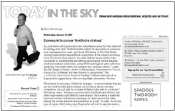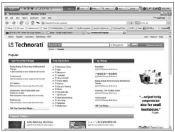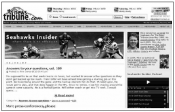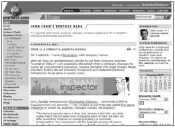Introduction
Kevin Cullen, a projects reporter for The Boston Globe, was introduced to the practice of blogging during the 2006 World Cup as a U.S. correspondent for the Goethe-Institut. Simultaneously he was filing for The Globe’s sports desk.
“The next day, I compared my words that had gotten into the paper with what I wrote for the blog,” Cullen wrote in the December 2006 issue of Nieman Reports. “The blog entry seemed better than the newspaper story. It wasn’t much longer, maybe by 300 to 400 words, but those extra words contained some good quotes, some stylistic segues, and a little more color. It was, without a doubt, a better read. Unencumbered by the need to squeeze words into a finite space, the Internet proved better for me, as the writer, and I’d argue for readers, too, than newsprint.”
Many new media analysts have suggested that every reporter should have a blog. That may not be feasible (or sensible), but scores of successful journalist blogs are currently online, allowing the blogger/reporter to cultivate a community with readers to test ideas, receive early and direct feedback and publish in the timeliest manner possible.
A good blog helps a blogger/reporter enhance his or her authority on a beat by adding the ability to publish information outside of the traditional news cycle and story format. It also helps the news organization establish a deeper relationship with readers and leverages the wisdom of the crowd for the benefit of the reporter’s coverage.
“Readers are our friends,” says Ben Mutzabaugh, who blogs about business travel for USA Today, when asked what he has learned as a blogger for the past five years. “In print it’s easy to feel you are at odds with readers because people will find one little thing wrong. So as a journalist you get defensive. The readers on a blog chime in and help you. They want you to get the story right. … Readers help make the blog stronger than any single author could make it alone.”
The rules are different with a blog.

USA Today’s Today in the Sky blog, written by Ben Mutzabaugh.
You can play off other information you find online, even linking to stories and blogs that might be thought of as “competition” but, in reality, are essentially all part of the virtual community conversation on a given topic.
A 2006 study by the Bivings Group found that 80 of the top 100 daily newspapers in the U.S. have at least one reporter blog on their Web sites. On 67 of these blogs, readers can add their own comments.1
Simply launching a blog is not good enough, however. Bob Cauthorn, a former editor at the San Francisco Chronicle, once noted the challenge for reporter blogs: “I think it’s going to be difficult for newspapers to do blogs right because their DNA continues to be trapped in the ‘we talk, you listen’ mode.”
A good blog is an ongoing conversation. It is facilitated by you, but, if it works, it may be dominated by your audience. If that happens, you win, the news organization wins and, most importantly, the readers win.
What is a blog?
I hate the term “blog.” It doesn’t sound the least bit revolutionary, technologically savvy or cutting-edge. But that’s exactly what blogs are.
Blogs have changed forever the way information is disseminated in our society. They’re fast. They’re interactive. They’re freewheeling. They can be dangerous. They are already powerful and growing more so every day.
Blogs usually have several common characteristics:
- A frequently updated online journal, written in a conversational style, with entries displayed in reverse chronological order (most recent stuff on top).
- Links to other news and information found on the Web complemented with analysis from the blogger (or bloggers).
- A “comments” link that allows readers to post their own thoughts on what the blogger is writing about. Not all blogs allow comments, but most do.
How did blogging become a phenomenon?
In the first information revolution in the 1990s, everyone started creating Web sites just to have one. The advent of blogs has paved the way for a more authentic information revolution.
The Internet of the 1990s was said to allow “anyone” to become a publisher. But it turned out that “anyone” needed to know a little bit about computers and, specifically, how to build a Web page. As a result, individual publishers were largely computer code jockeys and graphic artists and designers who were much more interested in pushing the cosmetic limits of this new medium. In essence, it was style over substance. Lots of flashy Web sites were built, but once you visited them, there often was little reason to return. Blogs flipped this model on its head. They’re not always pretty to look at, but they can be “published” by anyone who can click a mouse and type. The software makes it so easy to publish, in fact, that blogs can be updated several times a day with about the same effort as sending e-mail.
It was an effective way for citizens of all stripes to discuss the aftermath of the terrorist attacks in 2001. The energy created by those post-9/11 blogs morphed into passionate discussion and debate leading up to the military action in Iraq, then evolved in 2004 as election season shifted into high gear. Presidential candidates and the Republican and Democratic national committees hosted blogs, altering the perception of a blog as a grassroots communication tool and furthering the mainstreaming of the medium.
Getting started
Before you wrote your first news story, you read other news stories.

Technorati.com tracks blogs and allows you to browse by popularity.
Knowing the form of the medium is essential to understanding the fundamental components, such as the lead, the nut graph and the walk-off. So it is with blogs.
You should read blogs in order to write an effective blog. Finding the right ones to read will take a little searching, but is worth the time. Start by scanning the A-list bloggers on the top 100 at Technorati.com. Then visit other newspapers whose journalism you respect and check out their blogs. Then find blogs that cover the same subject matter as your beat and make a regular habit of checking them for updates. (You should be doing this whether you have your own blog or not, and now you can subscribe to them via RSS.)
As you read other blogs, both journalists’ blogs and independent blogs:
- Notice which posts you like the most, then distill: What makes it compelling?
- Note ways you could incorporate the best elements that you find.
- Track the frequency of posts. Does the blog update as often as you like? Or too often? Is there too much material to keep up with?
Terminology
OK, time for a little vocabulary. There are some new terms bloggers use to describe the mechanics of the medium and it’s important to know what they mean.
Post: An entry on a blog or, as a verb, to make an entry on a blog.
Permalink: A link available on each post that allows direct access to that post, usually with comments visible. This helps other bloggers link directly to a given post and helps readers e-mail a link to a specific post to friends.
Trackback: A mechanism for communication between blogs, allowing one blogger to let another know that he or she is linking to their material. This helps readers easily follow a conversation and helps bloggers know who is linking to each post. A pingback performs essentially the same function with slightly different technology. Trackbacks have fallen out of favor with some bloggers because they are susceptible to spam.
Blogroll: A collection of links usually found on the sidebar of a blog, it is designed to inform the blog’s readers of the sites the blogger frequently visits. The thinking goes: If you like my blog, then you’ll probably like other blogs I read. The links in a blogroll are most commonly other blogs but can be general or news Web sites, too.
Linkblog: A blog comprised of links to other online sources with little or no original commentary.
Vlog: A blog that features video commentary as its primary medium, as in “video blog.”
Moblog: Blogging from a mobile device, as in “mobile blog.”
Mechanics
While trained reporters have a built-in advantage with their experience in research, reporting and distilling facts and information, they are at a disadvantage when it comes to forming blog posts. Too many years of writing inverted pyramids and anecdotal leads bog down many a journalist-blogger’s posts. The goal in blogging is to write tight and be quick: Get to your point immediately and get out of there. You’ve got a story to file for print, after all.
Think e-mail: One way to get your mind around the idea of blogging is to think of it as an e-mail to someone you know. They know you’re “in the know” on this subject so you don’t have to work to prove your worth. You can be economical with your words but much more conversational than you’d be in a news story. Think about that long-winded e-mail you receive—that’s exactly what you’re trying to avoid.
Link, summarize and analyze: Attribution is, of course, important in a blog and it takes the form of links. A great post is sprinkled with links to other sites, news articles and even other blogs. Posts should vary in length but always be direct and to the point.
Be specific with headlines: A tendency for rookie bloggers is to be extra flippant with their writing once they have a blog, especially in the titles they use for their posts. Avoid this. A good blog headline—just like a good newspaper headline—previews the information the blog post will contain and does it in a compelling manner.
Be the authority—with a personality: The narrower the topic, the better. Not only will your audience clearly understand the subject matter covered, the blogger will have a better chance to present his or herself as the best source of timely information on that particular topic. And that’s the goal, after all: To combine authority with personality.
Frequency and handling comments
Be short with your posts: For your most loyal readers, you are the “middle man” between them and the sources of information they’re trying to follow. Anything you can do to connect readers directly to the source will build credibility for you and make your readers want to return to your blog. If you find a report online that will be the focus of an upcoming story, link to it with a blog post and simply say, “This is interesting. I’ll be writing about this soon.” And be done with it.

Mike Sando’s Seattle Seahawks blog.
Mike Sando, the beat reporter for the Seattle Seahawks at The News Tribune who won a 2006 award from Editor & Publisher for the best sports blog in the country, has perfected this technique. As soon as he leaves a press conference, he uploads the entire audio to his blog, allowing his readers immediate access to his source material. Then he follows up later with his analysis and then files a story for the next day’s paper (http://blogs.thenewstribune.com/seahawks/).
Post at least once a day: If you can be short with your posts, you can easily add at least one every day. That’s an important minimum to hit if you plan to build an audience. Ideally, you will post even more frequently. After all, if your beat is worth covering, there should be enough action to support this frequency.

John Cook’s Venture Blog covers venture capital and technology companies.
“I’m too busy!” Sure, we all are. But successful journalist-bloggers have found ways to make the blog work for them, saving them time instead of simply becoming an added time burden. You can use the blog as a notebook, compiling your notes and story ideas. It can help organize your thoughts. And if you build an audience, the leads and feedback you receive will forever change the way you approach your beat.
“A big innovation for me is the blog, though I promised that I would stop using the term,” said John Cook, who writes about technology companies and venture capital for the Seattle Post-Intelligencer. “One reason is that I think the term ‘blog’ confuses people. For me, it is simply an online publishing vehicle that I can use to cover my beat better.
“I now devote most of my time to the blog, partly because that is where my audience is. It has radically changed my job. I cover my beat—start-ups and venture capital in Seattle—more aggressively than I ever have. Part of the reason is that I have the flexibility to publish when and where I want without the concerns of whether the story would make it in the print edition.”
Handling comments: First, you should not start a blog unless you’re willing to allow comments. Some mainstream news blogs don’t allow comments, severely undermining the medium’s community-building function. (This might be a decision made above your pay grade that you can’t do anything about. But you should try.)
Second, you should embrace comments as a valuable reporting tool and not disdain them as many traditional journalists do.
You can cultivate comments by adding your own comments to any discussion that needs clarification, redirection or simply a vote of confidence.
… one of the reasons blogs are popular is that they embrace interactivity and give readers a sense of participation.
For example: “Great comments, everyone. Keep them coming!” You can highlight astute observations or pertinent questions by turning them into full blog posts. This will give you easy blog fodder and give your readers the sense they matter to you. That’s important because one of the reasons blogs are popular is that they embrace interactivity and give readers a sense of participation.
“When comments started landing on my blog, it dawned on me, ‘I can talk to these people,’” said Greg Reeves, who covers courts, police and special assignments, and does database and computer-assisted reporting for The Kansas City Star, where he started the Crime Scene KC blog in 2005 (http://blogs.kansascity.com/).

The Crime Scene KC blog is maintained by Kansas City Star reporter Greg Reeves.
“The interactivity was eye-opening. I was finally learning what people care about and what they don’t care about. Now I’m getting 300 to 500 comments a day, and online communities are forming in the blog.”
Comments can be like gold, but they can also tar and feather your blog. Don’t let a few bad apples ruin the conversation for everyone else. Rule the comments with a strict focus to staying on topic and maintaining respectful discourse. If it works, the comments will feel like a good pub on a Friday night with a rolling conversation. But sometimes people get out of hand and deserve to get thrown out.
Using photos and screenshots
Would you read a newspaper or magazine that had no pictures, graphics or art of any kind? Of course not. So don’t expect readers to flock to a boring blog without art.
If you work for a newspaper or magazine, you have access to a treasure trove of images. And as a reporter/blogger, you will likely be covering subjects that have been covered previously, so reusing file photos should be easy.
Most blogging software makes adding a photo to a post as simple as adding an attachment to an e-mail. Some systems will even resize the photo so you don’t have to. If not, and you pull a high-resolution image from the archives and need to size it down to save your page-load time (big pictures make Web pages very slow to load), use an online service like Snipshot to quickly resize an image without downloading and learning new software. (See Chapter 8 for more information on handling digital photos.)
Love it or leave it
Most people got into journalism because they liked it first, then found they had a talent for it. The same recipe will work on the blogosphere, too.
If you are considering a blog, do it for the right reasons. If it’s an assignment from a managing or executive editor, or it’s something you just feel obligated to do—don’t. You need to be passionate about your blog—just as you are passionate about your craft or your beat. If you’re not, you’ll be wasting your time.
In our newsroom in Tacoma, we say, “You have to love your blog.” And, while there is no measurement for blog love, it’s obvious after six months who loves and who loathes their blog. Mostly we’ve found that reporters, editors and even photographers—once they get started—wish they had more time to spend on the blog. For some it becomes the cornerstone for all their work. These reporter/bloggers can’t imagine working in a world without a blog, just like no one in journalism today can believe there was a time before e-mail and the Internet.
If you can find the fire to blog, you will reap the rewards.
Assignment:
Check out these award-winning newspaper blogs (winners of the 2006 Editor & Publisher EPpy Awards):
News—Crime Scene KC: http://blogs.kansascity.com/crime_scene
Business—Today in the Sky: http://blogs.usatoday.com/sky
Entertainment—MeMo: http://blogs.chron.com/memo
Sports—Seahawks Insider: http://blogs.thenewstribune.com/seahawks
1. “The Use of Internet by America’s Newspapers” study, The Bivings Group, 2006.
